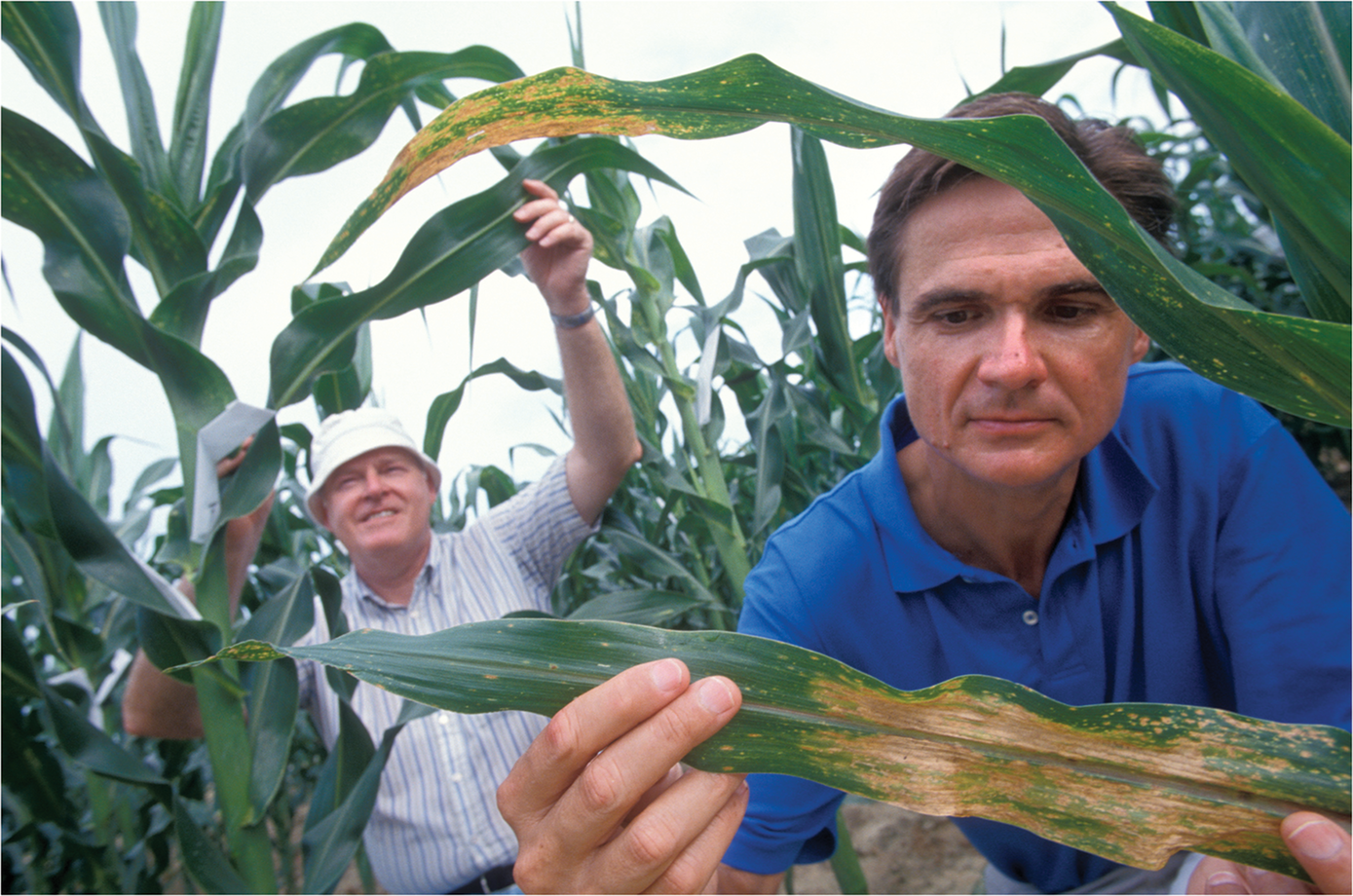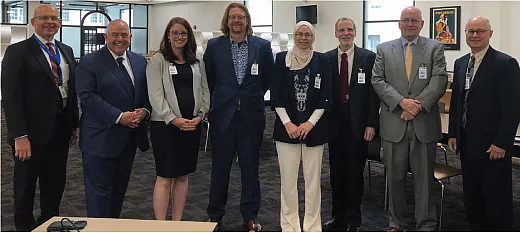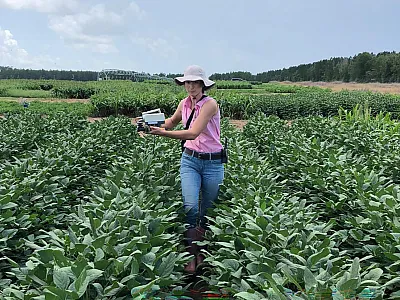Speaking a Foreign Language: Our Executive Federal Agency and Legislative Advocacy Visit

In late June, a leader representing each of our three Societies—ASA (Dr. Joann Whalen), SSSA (Dr. Michael Thompson), and CSSA (myself)—traveled to Washington, DC for our annual “executives visit” with federal agencies; led by our awesome science policy team (Drs. Rachel Owen and Julie McClure), CEO (Jim Cudahy), and CAO (Luther Smith). In total, we had nearly 20 meetings with different groups reaching dozens of agency leaders.
We discussed agricultural policy in biotechnology and supporting foreign visitors with the Department of State (DoS); food security and new initiatives with the Department of Defense (DoD); future research priorities with the Foundation for Food and Agricultural Research’s (FFAR) new director (Dr. Saharah Moon Capiton) and others; public–private partnerships with the American Seed Trade Association (ASTA); “food as medicine” with the National Institutes of Health (NIH); joint projects and awards with the National Academy of Sciences; federal climate change research coordination with U.S. Global Change Research Program (USGRCP); and international workforce training and biotechnology with the U.S. Agency for International Development (USAID).
Building Mutually Beneficial Relationships
We built relationships and advocated for our members’ work and our disciplines with each of these groups. It was powerful to share the many past accomplishments, activities, and return on investment of agricultural research. Of course, we also talked extensively with partners at different USDA agencies, meeting the new National Institute of Food and Agriculture (NIFA) director (Dr. Manjit Misra) and newly promoted Agricultural Research Service (ARS) administrator (Dr. Simon Liu), the head of National Agricultural Libraries (NAL; Dr. Paul Wester), and numerous leaders from the Natural Resources Conservation Service (NRCS) and Office of the Chief Economist (OCE).
Across all of these meetings, we heard how much agencies valued our annual visit and the importance of our scientific society advocacy. (Remember that these visits and advocacy only is possible from resources generated by you, through membership, publications in our journals, and attendance at our Annual Meeting.) We need these federal agencies, and they also need us if we hope to strengthen food and environmental security through agricultural research.
While the specific discussions of the meetings were wide ranging, a few issues continually rose to the top. Most frequent were topics related to policy and rules related to soil carbon and soil health and the future of carbon in agriculture. It was therefore important that we could point to the Societies’ Decode 6 (https://decode6.org/) project, which allows our members to provide specific input on topics related to carbon in agriculture. Another issue of great interest to many agencies was workforce development. We learned some federal scientist jobs are not even able to attract enough applicants to fill. Clearly, working in partnership is needed to help train the next generation. We can point to new initiatives developing in our Societies to do this training.

Towards CSSA’s priorities, data and data management came up frequently as did breeding, germplasm, and biotechnology. Surprisingly, artificial intelligence (AI) barely came up. Despite massive new federal investments in AI, there did not seem to be much use or direction of these tools yet. I think this creates a tremendous opportunity for CSSA membership to provide leadership to determine how to improve our work using AI. While discussion topics were largely biased by who we arranged to meet with, they also represent the pulse in Washington, DC right now around agriculture, which is necessarily “big picture.” Students and even experienced scientists would likely find that these broad brushstrokes of science facilitation are a different language than many of us are trained to speak.
We learned some federal scientist jobs are not even able to attract enough applicants to fill. Clearly, working in partnership is needed to help train the next generation.
Becoming Fluent Speakers in This Foreign Language
As a group of executives representing the Societies, we were able to spend lots of time together in meetings, at meals, and in Ubers and metros across DC, learning from each other. In these discussions, I was particularly fascinated with Dr. Thompson’s (SSSA President‐elect) thoughtful concept of (soil) chemistry as a foreign language. He philosophized that the point of his course is to teach students how to become fluent in speaking the language of chemistry before they can use it. This approach is true of talking to agency leaders about agricultural science too. However, unlike chemistry, there does not seem to be a formal class on this, but maybe there should be?
Agency leaders are less interested in which journal a study was published in or the details of our experimental designs than in how multiple studies align with the directives they have been given by stakeholders and Congress and what that means for how to position their agency going forward. Many agency leaders remain scientists, and you can still see their eyes light up when talking about specific experiments or findings; however, these activities are no longer their jobs or responsibilities. They have become true experts in the foreign language of agricultural science policy and facilitation, and we thanked them for their important service in advancing our disciplines. An issue of great interest to many agencies is workforce development as some federal scientist jobs are not even able to attract enough applicants to fill. USDA‐ARS photo by Keith Weller.
Prior to our meetings with agencies, I also had the honor of representing all three Societies to Congress, through an invited lunch with the Senate conservation caucus, followed by meetings with the House agricultural majority and minority committees and the Senate agricultural minority committee; guided again by our science policy team of Drs. Owen and McClure. In these meetings, we talked about the necessity of supporting agricultural research and focused on our four, well‐vetted Society priorities in advance of this year’s farm bill. These priorities included the needs to reauthorize and provide permanent baseline funding the Foundation for Food and Agricultural Research (FFAR), to reauthorize the Agricultural Advanced Research Project Agency (AgARDA), to improve coordination of agricultural climate research and climate‐smart agricultural practices, and to leverage networks to provide conservation technical assistance. Of course, we also discussed the important benefits of USDA, NSF, and other science‐based agencies, but these were primarily advocated for during appropriations at our Congressional Visits Day earlier in the year.
While specific scientific discoveries or projects occasionally came up in our agency meetings with legislators, the discussion (and what they care about) is much different. The great news is that everyone on the Hill loves agricultural research and wants to see it better funded. The less great news is that agricultural research does not often top stakeholders’ list of farm bill priorities. With the restrictive budget rules set this year, other agriculture and food priorities may have more support than expanding agricultural research. If this seems like a foreign language to you, it might as well be, and one you will need experience or training to speak if you want to help advance our discipline at the major pinch‐points of lawmakers and appropriators. I hope it is a language that you both learn and exercise through your career!
After being gone Monday to Friday with an 8 am to 8 pm schedule most days on this trip, I found myself sleeping for 12 hours after getting home early Saturday. Speaking a foreign language all week is exhausting but also critically important for our discipline to thrive. I hope you will remain a member, author, and meeting attendee of CSSA and other scientific societies to help support similar activities of our Society representatives in the future!
Text © . The authors. CC BY-NC-ND 4.0. Except where otherwise noted, images are subject to copyright. Any reuse without express permission from the copyright owner is prohibited.











